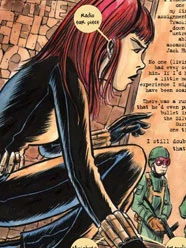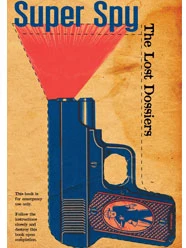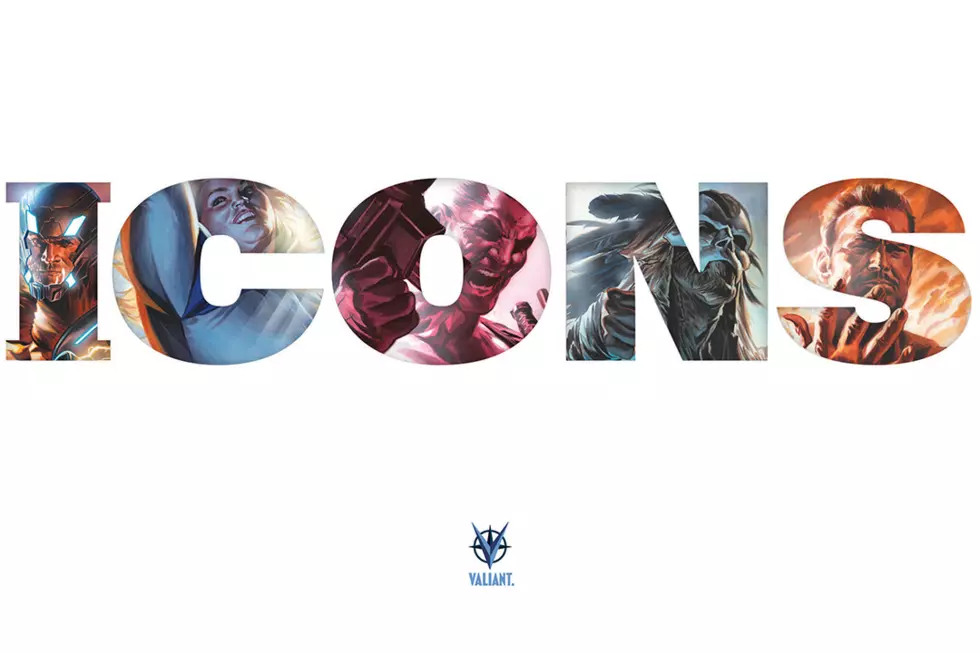
Kindt Slow Down: Matt Kindt Discusses His Mighty Release Schedule
Matt Kindt has a hectic year ahead of him. The Missouri cartoonist and graphic designer's latest release, an 8-page addendum to 2009's "3 Story: The Secret History of the Giant Man" hit MySpace Dark Horse Presents this week, which will be followed by the release of "Super Spy: The Lost Dossiers" later this month and the launch of Vertigo's "Revolver" in July. With so many creator owned projects in the pipeline (plus a full summer convention schedule) we contacted Kindt to get his take on staying inspired while maintaining a prolific schedule.

ComicsAlliance: As different and separate as it is from your other work, one of my initial (and admittedly sci-fi infused) impressions of "3 Story" was that it would make a pretty fascinating "Super Spy" installment due to its espionage elements. Can you tell us a little about the impetus for the book and how it might relate to some of your previous projects
Matt Kindt: Well, coming off of Super Spy I have to admit I was sick of spies. I felt liked I'd mined every spy idea and story I could and had nothing left to add. The Giant Man idea came from a second cousin of mine who actually had the medical condition that I detail in the book -- he kept on growing but they were able to cut the tumor out and he is fine today -- really tall but he lives a normal life. So I got to thinking of when and where I was going to set the story and I thought the cold war era would be interesting and then some of that old spy research I'd done started to creep back into my head as I was writing -- the details about Houdini and Billie Holiday being spies -- so I thought it would be kind of funny to have this guy that is impossible NOT to notice be a sort of spy/courier. The old 'hiding in plain sight' kind of thing. So, I still haven't gotten away from spies completely -- as hard as I try.  CA:"Giant Man in The Philippines" is your third "MySpace Dark Horse Presents" entry following "The Secret Files of The Giant Man in Paris" and "The Secret Files of The Giant Man in Egypt." (which I guess technically makes "3 Story" "6 Story" If I count the narrators) Did you have these shorts in mind before completing "3 Story" or did these stories come to you as you reflected on the completed work a bit?
CA:"Giant Man in The Philippines" is your third "MySpace Dark Horse Presents" entry following "The Secret Files of The Giant Man in Paris" and "The Secret Files of The Giant Man in Egypt." (which I guess technically makes "3 Story" "6 Story" If I count the narrators) Did you have these shorts in mind before completing "3 Story" or did these stories come to you as you reflected on the completed work a bit?
MK: I had a lot of additional material that I ended up cutting out of 3 Story or ideas that just didn't fit the narrative flow. The most important thing for the book was that we never get Craig's point of view directly. But I also didn't want it hopping around to a bunch of different characters -- I wanted it to be about the women in his life. But I had ideas for all these other aspects to his existence that his wife and daughter and mother just wouldn't know anything about. So I had the stories just sitting around -- more of his back story and character development and when Dark Horse approached me it was a perfect fit. I had these ready to go and I was more than happy to crank out some extra material. I think the Giant Man in Paris story might be my favorite thing I've written so I'm glad it found an outlet. A lot of that woman's character was based on a funny story that a friend of mine told me when I was in Paris about this girl who jumped in the river on a dare and it always kind of stuck with me.
The other element of that story -- the stick that she props her window up with -- came to me while I was watching Brokeback Mountain of all things. Towards the end, he's looking through his childhood house and he props the window up with this scrap piece of wood. I have no idea why that little scrap just sparked something in me -- but I got the whole idea for the back story of this piece of wood. That's also a good example of why I have to watch movies several times -- my mind ends up wandering in odd directions all the time.
CA: Just as readers get to revisit "3 Story" through its newest chapter, you'll be revisiting "Super Spy" with "The Lost Dossiers" this month. From what we've seen (including our preview of the book's 3-D section) it seems like you had a lot of fun stepping back into that world. Do you have any favorite memories from working on the book?
MK: My favorite memory was actually finishing it. I'd set this crazy goal for myself to complete a story every week for a year and it nearly burned me out all together. But I was happy that I proved I could keep up that pace and not sacrifice the quality of the work. Other than that, the most fun thing has been just going to conventions and hearing from so many people that connected with the book. That is really satisfying -- that I'm not just working in a vacuum but there are other people out there like me, that have the same love of history and spies and super sad stories...
 CA: Your next project, "Revolver," features a story set at least partially in your neck of the woods. Was the decision to set your story in St. Louis a case of "writing what you know?" Are there any other direct parallels between your personal experience in the series?
CA: Your next project, "Revolver," features a story set at least partially in your neck of the woods. Was the decision to set your story in St. Louis a case of "writing what you know?" Are there any other direct parallels between your personal experience in the series?
MK: When I was writing Revolver, initially it was set in Chicago and St. Louis and then I shifted it to St. Louis and Kansas City somewhere in the process. I actually kind of hate 'writing what I know' -- it ends up being kind of boring to me. What I usually do is pick out a place I'd like to visit or learn about and then visit that place, or research it -- just to keep me interested. It's a great excuse for travel as well. But in this case, the story really needed to start in the midwest. It just fit the themes of where the characters started and ended up. There is some San Francisco in there -- because I love that city -- but it also kind of fit the geographic necessities of the story.
There are a lot of other personal things in Revolver -- I put a lot of my former co-workers from my old day-jobs in there and I definitely channeled a lot of the feelings that I had while I was sitting in an office all day. So a lot of what is in there was really kind of me 10 years ago.
There's also a little commentary on my feelings about modern comics, a little snippet of my dad teaching me how to drive a stick shift, and the best sequence involving flip-flops ever in comics (only half kidding). My favorite part of that book though, came towards the end. I was designing the page numbers of all things when I got the idea to do a 'news-ticker' across the bottom of every page that not only incorporated the page number but also told several other stories simultaneously. So you can read the entire book then go back and read the scroll across the bottom and get a lot of back story and an entire new story line.
CA: As both a writer and an artist, your workflow calls on a lot of different disciplines. Do you make any kind of mental distinction between your writing and illustrating duties or does it feel like more of a consolidated process to you?
There's definitely a distinction for me. The writing and even the thumbnail layouts I do is the fun part. The part I love the most. It's where all the ideas happen and the figuring out of what the book will look like and how it will work. Everything after that -- the penciling, inking, etc. is purely production for me. I enjoy inking -- but usually only for the first 20 or 30 pages. After that it is really a grind. I think it's because the fun and challenge is in figuring out the story and how it will be told.
I end up watching (listening) to a lot of TV and movies while I ink to keep me going...
 CA: Since the release of "Pistolwhip" and "2 Sisters," it seems like a wider array of colors and arguably a certain level of detail (more realism, more diagrams, etc.) has kind of organically found its way into your artwork. What's your thought process when it comes down to finding the right look for your stories?
CA: Since the release of "Pistolwhip" and "2 Sisters," it seems like a wider array of colors and arguably a certain level of detail (more realism, more diagrams, etc.) has kind of organically found its way into your artwork. What's your thought process when it comes down to finding the right look for your stories?
MK: To me, the art and look of the book is always driven by the story. I usually come up with the action and dialogue and then think about how to best present it. Story ideas and character arcs work pretty much the same across different mediums -- movies, books, television -- they all kind of work the same so the trick is to present this story and these ideas in comics in a way that only comics and graphic novels can do. With Super Spy, I really wanted that book to look like an old moldy piece of paper that you'd found down in someone's basement to give it that feeling of a found object -- something you weren't necessarily supposed to be looking at.
WIth "3 Story" I did something similar with the color of the background paper -- it's subtle but if you look through the book the 1940s sequences are the same as Super Spy's paper, then as we progress to the 60s the paper becomes a little less yellowed and then the modern day at the end is nearly white -- to sort of show the progression of time in the story.
CA: Your Black Widow story from Marvel's "Strange Tales" anthology tread some pretty suitable territory for you. Aside from your continued creator-owned work, are there any established characters (of any genre or medium) that you'd like to put your spin on?
MK: It's funny, because I feel like any of the company owned books and characters would be fun to work on. They all come with their own back stories and history and playing with (and off of) that is really fun. I specifically requested Black Widow because of the spy aspect and I liked that she was this normal human in a super hero world. She's a little more grounded and a little more remarkable because of that. I have a great idea for her entire back story and history that I just haven't had time to even bug my editor there about.
I grew up with all of the Marvel and DC characters. Daredevil was always a favorite but for some reason the Legion of Super Heroes has always been one thing I've loved as well. I really enjoyed the Giffen run where they rebooted it back in the 90s. I have a great Legion story too but again, with my own books I don't have a lot of time left to be pitching books and ideas lately. But one of these days I'll get around to it...
In the grand scheme of things though I think I'd just as much like to take something like Guardians of the Galaxy or something more obscure that hasn't really had a definitive run and do something with it. In the end, it's not the characters as much as it is how they're written and the story that's being told that makes it good. And you can do that with any character in any setting really.
 CA: Over at your blog you wrote about your December trip to the Lucca Italy Comics Festival where you signed several hundred copies of "Super Spy" with unique sketches. Rather than complain about a sore drawing hand or an addled mind, you celebrated the challenge (which I really appreciated as a fan). What are your plans for this convention season? Given the number of projects you'll have out, are you expecting a pretty busy schedule?
CA: Over at your blog you wrote about your December trip to the Lucca Italy Comics Festival where you signed several hundred copies of "Super Spy" with unique sketches. Rather than complain about a sore drawing hand or an addled mind, you celebrated the challenge (which I really appreciated as a fan). What are your plans for this convention season? Given the number of projects you'll have out, are you expecting a pretty busy schedule?
MK: Yeah -- you know the thing about signing book is this. Five years ago I'd sit at a con and maybe sign a handful of books and it was really kind of depressing and more than a little boring. So now I really appreciate so many people coming to shows and wanting things signed. When I was in Angouleme a few years ago, I was watching the local artists sign books for the fans and they were doing these elaborate brush and ink and color sketches in every single book. That really had an affect on me. I mean, why not? Doing the same simple head sketch in a bunch of books for hours is ridiculous to me. It's not fun as an artist and even as a fan, your book just looks like every other one. So I made a conscious effort after that to make every sketch I do as elaborate as I can and different than every other one. It really ends up keeping you on your toes -- to me it's as close to the kind of thrill I imagine a musician gets when he's improving in front of an audience. You're using ink in someone's book and there's not penciling first and erasing -- it's a drawing you've never done before without any guides and it keeps it fun.
I'm really excited about a new book I'm drawing for Oni - I've specifically designed the book so that I can do something (secret for now) to it that has never been done in the history of book sketches and signing. I can not wait!
More From ComicsAlliance
![Aric Is Having A Bad Day In ‘X-O Manowar’ #1 [Preview]](http://townsquare.media/site/622/files/2017/03/XO00.jpg?w=980&q=75)
![Journey Through The Shadows Of Deadside With A First Look At ‘Rapture’ [Previews]](http://townsquare.media/site/622/files/2017/03/Rapture00.jpg?w=980&q=75)



![Aric Fights His Way To The Top In ‘X-O Manowar’ #2 [Preview]](http://townsquare.media/site/622/files/2017/01/XO00.jpg?w=980&q=75)
![Take A Tour Of Britain’s Greatest Super-Prison In ‘Ninjak’ #23 [Preview]](http://townsquare.media/site/622/files/2017/01/Ninjak00.jpg?w=980&q=75)

![Matt Kindt And Tomas Giorello Relaunch ‘X-O Manowar’ With ‘Soldier’ In 2017 [Exclusive Art]](http://townsquare.media/site/622/files/2016/12/XO00.jpg?w=980&q=75)
